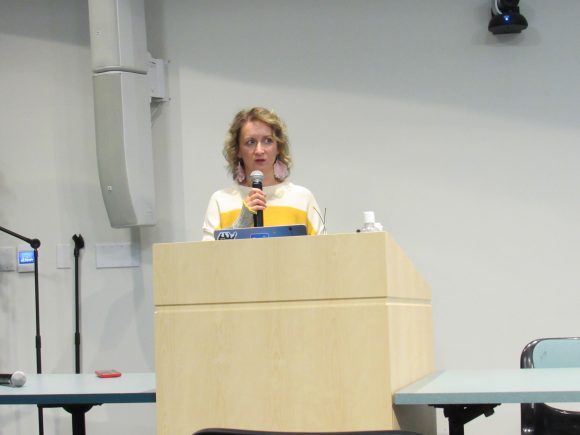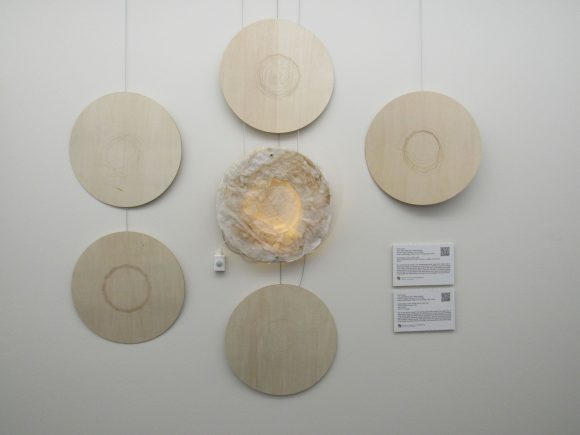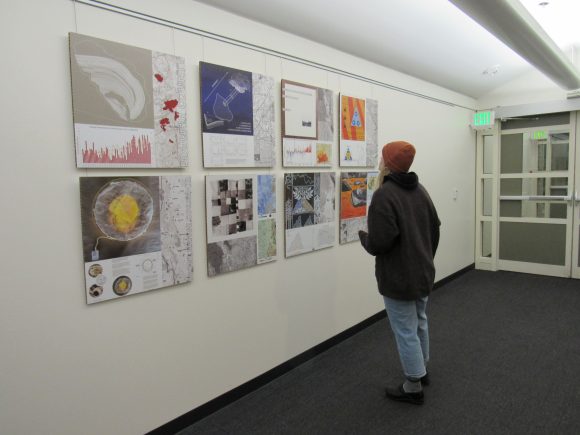
Bioartist Darya Warner speaks at the opening reception of the “Coloradans and Our Shared Environment in Times of Challenge and Change” on Jan. 18 (Jessi Sachs/CU Independent)
For bioartist Darya Warner, the path to their somewhat unconventional career was a tumultuous one, beginning in post-Soviet Ukraine and bringing them nearly 6,000 miles away to the United States Air Force Academy in Colorado Springs.
Warner, who uses both she and they pronouns, is a Colorado Art Science and Environment fellow. The CASE fellowship pairs fellows with University of Colorado scientists to explore Colorado-specific climate issues through collaborative artistic and scientific research. Her work for “Coloradans and Our Shared Environment in Times of Challenge and Change” is currently on display in CU Boulder’s Sustainability, Energy and Environment Complex.
For Warner, the project has been a sort of homecoming, combining their long-held interests in both the scientific and artistic worlds.
“I always drew as a kid, but I never considered art as a profession because back then, this was not feasible because you have to be coming from a wealthy family,” Warner said. “Usually in post-Soviet countries, it was more about getting (what) they call a ‘real degree,’ like a doctor or lawyer… But I was always interested in science as well.”
This cultural bias against careers in the arts led Warner through a stint in law school in Belarus, researching nuclear power legislation and regulation, a subject that they noted was of special interest due to the nation’s contamination after the Chernobyl disaster.
Ultimately, after Warner’s research was rejected for publication, considered too “hot” under a governmental dictatorship, they decided to take a fateful leave of absence.
It was during this leave in 2001 that Warner was presented the opportunity to come to the U.S. on a work and travel exchange program that brought them to work in children’s summer camps in New York City just before the Sept. 11 attacks on the World Trade Center.
“We worked really long hours, and looking at this now from perspective… this was total discrimination in a lot of levels and also on the level of being an immigrant, speaking with an accent,” Warner said. “You’re just being treated like a servant.”
While the hours were long and their time after arriving in New York was marked by other struggles, such as losing all of their completed law school credentials in the overseas transfer, it was also Warners’ immigration to the U.S. that led them back to pursuing art.
“I decided… I’m here, and I can do actually whatever I want and learn whatever I want,” Warner said. “(I thought), ‘Well, I have a gift of drawing, why don’t we apply that some way or another?’”
Warner said they tried out paths ranging from fashion design to graphic design before enrolling at New York’s School of Visual Arts, another fateful decision as the school opened up a Bio Art lab as a part of its fine arts department during their time as a student.
“That was it. That was exactly why I was there. It was like perfect. It was like everything I’ve done before that led me to that moment,” Warner said. “That’s the place where you combine the art and science… we got to work with scientists and got to do stuff in the lab. So that science part of me that always wanted to participate was like, ‘That’s it.’”
After earning a master’s degree in Bio Arts, Warner accepted a job in Colorado Springs teaching at the United States Air Force Academy.
It was here that Warner first noticed one major difference in the climates of Colorado and New York, where she’d originally landed after immigrating.
“I didn’t know anything about Colorado except it was really dry here,” Warner said in their speech at the opening reception of “Coloradans and Our Shared Environment in Times of Challenge and Change,” the art exhibition that is the culmination of the CASE program. “What I was interested about the lack of water (was that) I felt this anxiety right away when I got here, especially from the East Coast, and just this general anxiety about water and water issues.”
After being paired with Suzanne Anderson, a researcher and professor of geological sciences at CU Boulder, the team knew exactly what climate issue they wanted to tackle with their work.
“We definitely wanted to work on water,” Anderson said of her shared interest with Warner.
The pair ultimately landed on combining their artistic and scientific skills to create art concerning the importance of groundwater, specifically through using wells to measure groundwater’s involvement in how water moves throughout the water cycle.
It is a topic of concern for Coloradans, especially considering the historic drought that has impacted the state in the last two decades.
“Everybody has something to say about water. Everybody was excited, from little kids to older folks who have been living here for a long time,” Warner said. “(Coloradans) did know what’s happening on the local level, but they just don’t know what’s happening across the state. And I wanted to know what’s happening across the state.”

A piece of Warner’s art concerning groundwater. The piece is interactive to describe human impact on the climate. (Jessi Sachs/CU Independent)
For Warner to accomplish this took careful and dedicated research. Something that, according to Anderson, speaks to their personality and devotion to art.
“I’ve admired her persistence in really having an idea and pushing it forward,” Anderson said.
Warner and Anderson’s work, along with a number of other teams of CASE fellows and scientists, is on display at SEEC through Feb. 24, when it will then join the rest of the collaborative works from the project on a traveling tour around the state.

An attendee of the “Coloradans and Our Shared Environment in Times of Challenge and Change” opening reception looks at a display explaining some of the artwork, including Warner’s. (Jessi Sachs/CU Independent)
“I’ve been really pleased with the energy that she’s brought to this (and) her persistence,” Anderson said.
These qualities, noted by Anderson, are the same reasons that Warner herself believes they were able to succeed in both the artistic and scientific worlds.
“It’s like the quintessential American Dream… If you work hard, you will get somewhere, and I am a good example of that,” Warner said.
Contact CU Independent News Editor Jessi Sachs at Jessica.Sachs@colorado.edu.
